New strata laws that come into force today will make it easier for apartment owners to update or redevelop ageing unit blocks.
Previously, a strata scheme can only be terminated if 100 per cent of owners agree, but from today, a vote of 75 per cent will allow the collective owners to either sell the property or redevelop it themselves.
Lannock Strata Finance CEO Paul Morton, whose company is a leader in strata loans, says the reforms represent a golden opportunity for owners of ageing apartments to update their homes to improve the value of their assets.
“The new laws have been designed to not only make it easier to update ageing buildings, but to increase density as part of the government’s urban renewal strategy,” said Mr Morton.
“Apartment owners can choose to cash in by selling to a developer, but they may be better off holding on and redeveloping their property to perhaps add a penthouse or other amenities with the benefits shared by all owners.”
A report conducted by the UNSW City Futures Research Centre, Renewing the Compact City, indicates up to 15 per cent of strata schemes (2,600 schemes) registered before 1990 could potentially be redeveloped as low-rise buildings up to three storeys, and a further 33 per cent (5,729 schemes) up to 10 storeys.
It suggested gentrification of low-rise schemes would most likely be the driver in locations such as the eastern suburbs, north shore and near the ocean and harbour. Densification up to 10 storeys was more likely in middle-ring suburbs.
One of the authors of the Compact City Report, Hazel Easthope, said that government and stakeholders have been looking at ways to address the problem of ageing apartment buildings while delivering greater housing density.
“The aim of the project was to look at whether there are equitable and viable solutions to redevelop older multi-unit strata title housing to achieve higher densities without exacerbating social inequalities or causing social disruption,” said Dr Easthope. “Over the past decade, there has been extensive urban consolidation and densification in former industrial areas. Now we are looking at the regeneration of existing residential areas which presents a more complex challenge.”
The report notes that many of these older strata schemes in the inner and middle ring suburbs and around transport nodes sit on land that is under pressure from planners, politicians and developers for more intensive use. Added to that, many are reaching a point in their life cycle where substantial reinvestment may be needed to upgrade ageing amenity.
At present, around one-quarter of housing in Sydney is strata titled and this figure is predicted to rise to 50 per cent by 2040. Currently 65 per cent of new housing approvals are for apartment development.
Mr Morton said that of the many options open to apartment owners, the least disruptive and most equitable involved renewal in the form of additions to increase density with the bonus that this could pay for the costs of refurbishing the existing building.
“The part of the strata reforms relating to the collective sale and renewal process has been the most widely criticised because of the potential impact on vulnerable or elderly residents,” said Mr Morton.
‘However there are many creative ways to undertake renewal that don’t involve selling out to a developer. Owners can collectively undertake the renewal work or do so in partnership with a developer.
“This approach allows lot owners to retain ownership and enjoy the benefits of an upgraded apartment building, with the only disruption being the inconvenience of a renovation.”
Since the new legislation was presented to parliament last year, Mr Morton said there had been a spike in inquiries from apartment owners and Strata Managers seeking finance for strata renewal projects.
Strata loans are a great alternative to special levies, or waiting for sinking funds to accumulate. They often have superior economic benefits and are particularly well suited to renewal projects.
“We’ve really only scratched the surface of what will be required in coming years,” said Mr Morton. “There are thousands of strata properties around Australia that were built before 1980 and owners would see great value from renewal projects that will increase the value of their assets”
“Many people are realising that their shabby 70s unit is a potential goldmine if the common property is improved.”

